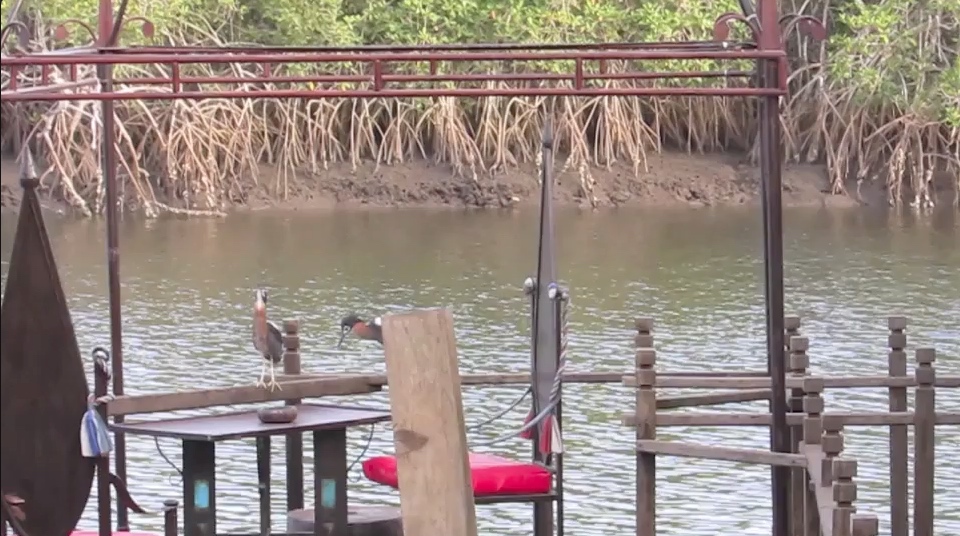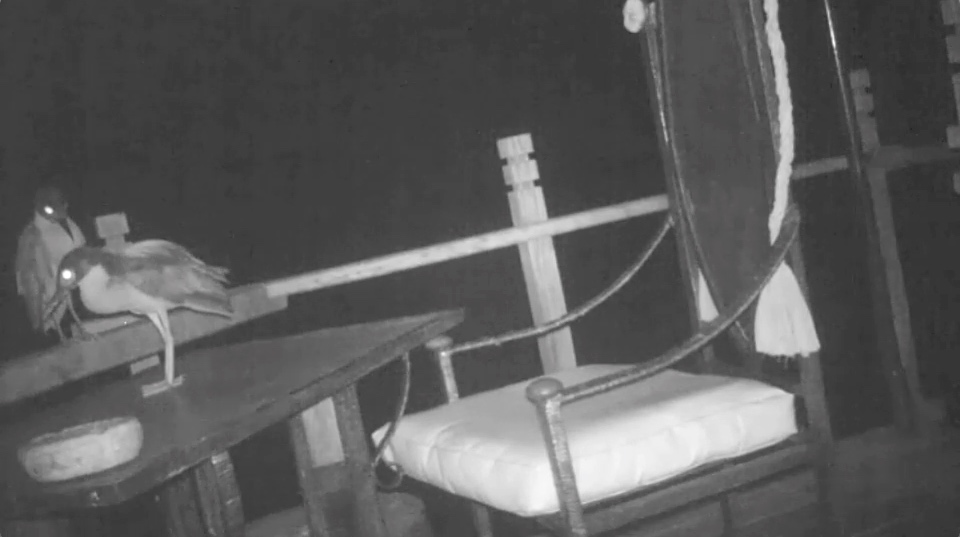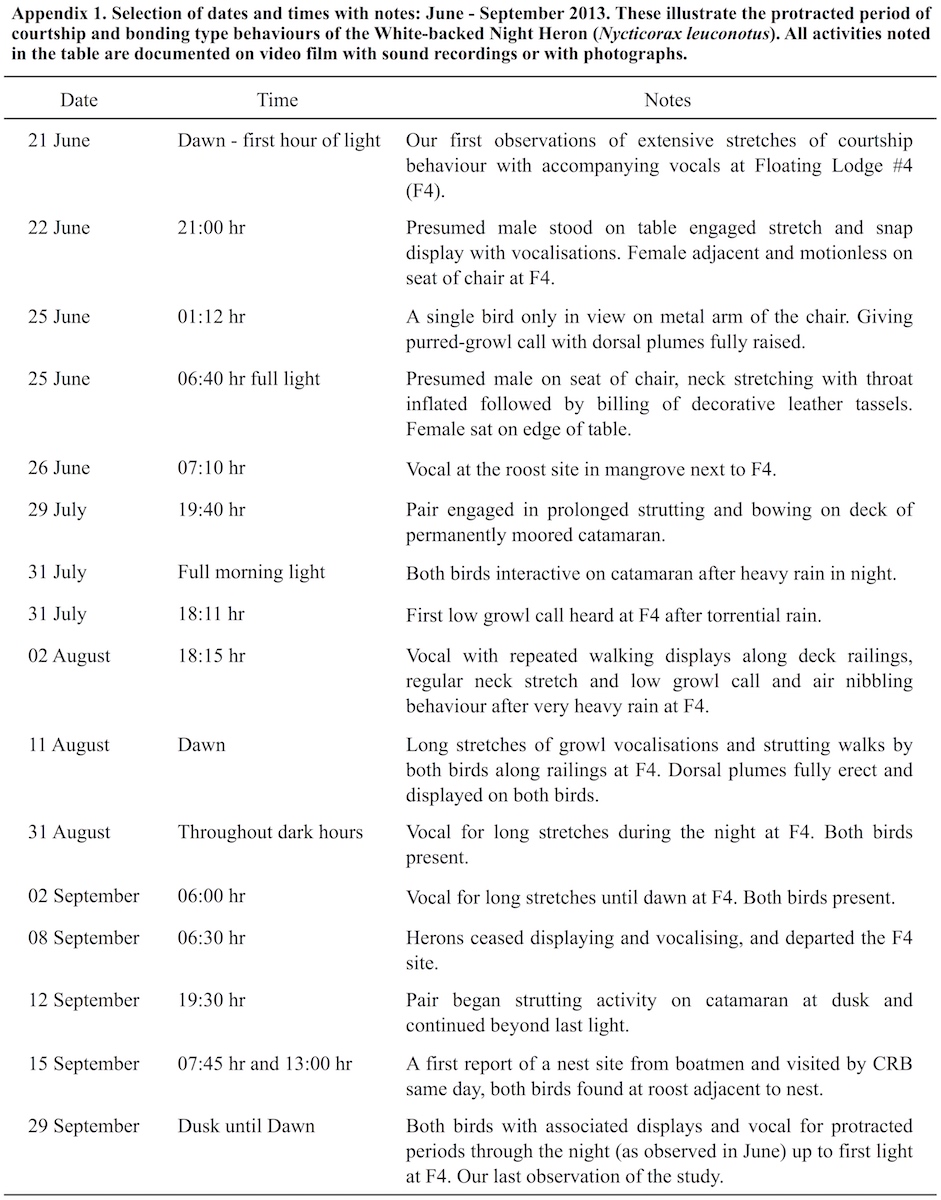First observations and film of the courtship display of White-backed Night Heron (Nycticorax leuconotus) in The Gambia, West Africa
Abstract
We report here, for the first time, on aspects of courtship displays and associated behaviour of the White-backed Night Heron (Nycticorax leuconotus). Additionally, we present film documentation of the proceedings prepared by using a trail camera. While considered, for the most part, reclusive, we observed a pair of birds displaying in open and exposed circumstances during both dark hours and in full daylight on multiple occasions from June to September 2013. Very little has been documented about the species’ behaviour largely attributed to its reclusiveness. However, our observations were made on birds that were far from reclusive. The herons displayed on a secluded but occupied floating lodge accommodation anchored on the side of a narrow tidal saline creek system in The Gambia, West Africa. We describe the species’ ‘Stretch’ and ‘Snap’ displays and comment on their implications towards a better understanding of the biology of this species.
Key words: Ardeidae; behaviour; breeding; courtship; Stretch display; Snap display; The Gambia; West Africa.
Introduction
The courtship behaviour of the White-backed Night Heron (Nycticorax leuconotus) is undocumented (Kushlan and Hancock 2005). The species occurs widely but uncommonly in wetlands throughout sub-Saharan Africa. The species was not documented in The Gambia before 1963 nor documented as breeding there until 1984, after which observational records increased (Gore 1990). Barlow et al. (1997) consider the species to be uncommon, becoming very locally common when breeding from August to October at a few well-watched sites in Western Region and North Bank Region with records from all months and all river regions. Most records of breeding information have occurred during the mid-late rains with nest-building in mid-August, eggs in mid-September in Western Region and most fledging records in late September or early October; there is an exceptional record of feathered young in May (Barlow et al. 1997). In addition, a handful of other annually used breeding sites have been discovered over the last 20 years throughout the country.
The White-backed Night Heron nests individually rather than colonially, placing its nest low over water or even on the ground in wetlands (Kushlan and Hancock 2005). In The Gambia, it breeds on the fringes of heavily vegetated freshwater ponds, water courses and drainage channels. Important saline nesting habitat constitutes tall Rhizophora mangrove-fringed creeks and breeding records also occur from low Avicennia coastal mangroves. It appears to be the most nocturnal of all Africa’s herons with diurnal sightings occurring mostly during the breeding season. At a number of well watched locations in The Gambia, it is habituated and tolerant to regular intrusion by groups of birdwatchers and photographers approaching roost sites on foot and in small boats during the day (pers. obs.). In this short paper, we describe, for the first time, aspects of its courtship behaviour and comment on the implications of these observations toward a better understanding of the biology of this species.
Methods
Observations were made at Mandina Eco-lodges, Makasutu, Western Region, The Gambia, West Africa (13° 18' 39" N, 16° 36' 32" W). To compliment a number of forest lodges, the resort consists of four floating lodges fixed to the bank some 50 m apart on a stretch of the Madiana Creek within the extensive Tanbi Wetland mangrove complex, inland of the mouth and south of the Gambia River. Adjacent habitat consists of a tidal grassy marsh fringed with fragments of intact high and secondary forest thicket. The whole area is protected by the private ownership of the Makasutu project. For a species long considered reclusive, shy of study and difficult to approach (Hancock and Elliott 1978), our observations were made as the birds displayed along wooden railings, on top of a metal table top with adjacent chairs, and on the open deck floor of the lodge accommodation (Fig. 1). On a number of occasions the birds were seen actively performing on the deck of a catamaran moored about 200 m from the lodge in an adjoining creek. The two sites were separated by high and dense mangroves. We observed and recorded the behaviours of the herons using a digital camera and a trail-cam unit set to take either still images or video clips on different dates during the study period and with direct observation using binoculars. The study was made on three to five dates per month from 21 June to 5 October 2013 when CRB occupied one of the floating lodges (Fig. 2, Floating Lodge #4) on a series of overnight stays in order to conduct the inquiry. Most rains in The Gambia are recorded from June to October with minor rainfall recorded for the month of June in 2013. Behavioural terminology follows Kushlan (2011).


Results and Discussion
We observed two White-backed Night Herons, presumably a pair engage in interacting courtship behaviour while standing and walking along on the rail of the lodge deck (Video 1). They were in bright breeding plumage, most distinctively showing the white dorsal plumes that give the species its common name (Fig. 3). The usually hidden plumes were clearly raised, fanned and fully exposed during the ‘Stretch Display’ and assumed the semblance of a huge snow flake (Fig. 4). Inflation of the throat causing movement of feathers was visible by the presumed male during the Stretch Display. The skin around the eyes was also ‘ghostly’ white and similarly apparent during displays. The head was an indigo-black, throat and neck were cinnamon. The bill and legs were not distinctively coloured for breeding. The bill was a dark brown horn-colour and the legs greenish yellow, often marked with mud. Both the plumes and the chalky white eye patch would likely be particularly obvious for enhancing nocturnal and crepuscular behavior (Video 2). The primary courtship display observed was the ‘Stretch’, shown only by one bird, likely the male. The bird positioned itself horizontally, with bent legs, raised its bill vertically with the back of its head touching its mantle. It then elevated its bill and neck vertically. The bill was then brought down to the horizontal. In this position, the bird gave a call sounding like a low growl and erected its dorsal plumes. On occasion, this motion continued into a ‘Snap Display’ with the bill and head continuing downward below the feet and ending in a bill snap. The Snap Display was also given independently, aimed away from the presumed female recipient and so, showed no agonistic component. The recipient bird mostly stood and observed without trying to leave or make close contact with the displaying bird. It occasionally gave a quiet bill snap. One observation of an attempt by the presumed male to place its head over the back of the recipient was thwarted by the presumed female whilst walking. Both birds nibbled the air with their bill without a snap sound. Between displays, the presumed male also billed the decorative leather tassels attached to the chair, as it might a twig or other vegetation. This could be considered a normal part of courtship had it been directed to potential nesting material type items. Alternatively, in this case, it perhaps manifests as an example of displacement activity.




The courtship behaviours recorded on film were comparable to those described for herons in Kushlan (2011). However, that the observations took place in full view of onlookers standing on man-made structures, through open curtains and windows and from the elevated walkway to the accommodation, at a distance of about 10 m from the deck where the displays occurred, was totally unanticipated from what was previously known of the species’ biology. These observations show that this species may not be as reclusive as presumed in the literature (Brown et al. 1982, Kushlan and Hancock 2005). In this case, even the sporadic movements of nearby people were tolerated but did, on occasions, cause the birds to move off to the cover of the mangroves and then subsequently return after a brief period of time. Long periods were spent motionless, at rest in adjacent mangroves close to the lodge during the day (Fig. 5). The behaviours continued at a low intensity over long periods and lacked agonistic overtones typical of pair establishment in heron; thus suggesting that the individuals were familiar with each other and were likely synchronizing breeding rather than establishing a new pair bond. Continuous and vocally accompanied displays were maintained for well over one hour on a number of timed observation periods, e.g., 21 June and 2 August. Other observations included breaks involving departures and returns to the lodge site, e.g., 29 September, when up to 11 hours of activity were involved (see Appendix 1 for further details). We acknowledge that more focused work is required in this aspect.


On 15 September, approximately 12 weeks after we made our first display-type observations (on 21 June), we discovered a rudimentary nest platform about 120 m downstream from the courtship site across open water. There were no eggs on the platform but two White-backed Night Herons were present beside it in somnolent daytime roost. We believe that these adults were the same ones we observed doing the courtship displays on the floating lodge. We have two reasons for believing this: 1) The boatmen of the Mandina Lodge, who know the area very well and have competent local bird knowledge, confirmed having never observed more than two adults together along this stretch of the creek in a single observation period. 2) The daytime roost site, illustrated in Figure 5, close by the floating lodge display area, was seen to be unoccupied after the nest was located. However, the birds regularly reappeared, at nightfall, at the courtship ground and continued the ritualized courtship performance for the duration of the study, which ended on 5 October. Thus, these observations suggest that courtship could occur in fully exposed and in half-light conditions of dusk and dawn, away from the immediate location of the nest site. These behaviours would be expected in sedentary dispersed-nesting herons (Kushlan 1983, Kushlan and Hancock 2005).
To our knowledge, these constitute the first courtship observations for White-backed Night Heron anywhere in its range with or without the presence of man-made structures. Nuptial displays at other sites could be performed along the limbs of, e.g., large horizontal mangrove buttresses and on fallen flattened tree trunks at freshwater sites or on the ground. The Gambia, where breeding White-backed Night Herons are relatively easy to access, would make an ideal location to conduct further fieldwork into the ecology of this understudied heron.
Acknowledgements
CRB thanks Lawrence Williams, management and staff at Mandina Lodges, and Makasutu for hospitality, help and equipment loans, which made this study possible. Able Gambian boatmen are thanked for sharing valuable knowledge on their and the herons’ home ground. Dave Montrieul is thanked for his quality images and co-operation in the field. Neil Edward made helpful observations and contributed to the trail cam effort. Russel Cryer and Francis Mendy kindly assisted with various logistics. Chip Weseloh and Katsutoshi Matsunaga contributed significantly to the presentation of the publication.
Literature Cited
Barlow, C., T. Wacher and T. Disley. 1997. A field guide to the birds of The Gambia and Senegal. Pica Press, Robertsbridge, U.K.
Brown, L. H., E. K. Urban and K. Newman. 1982. The Birds of Africa. Vol. 1. Academic Press, London, U.K.
Gore, M. E. J. 1990. Birds of The Gambia. Check-list 3, 2nd ed. British Ornithologists’ Union, Tring, U.K.
Hancock, J. and H. Elliott. 1978. Herons of the World. Harper & Row, London, U.K.
Kushlan, J. A. 1983. Pair formation behavior of the Galapagos Lava Heron. Wilson Bulletin 95: 118-121.
Kushlan, J. A. 2011. The terminology of courtship, nesting, feeding and maintenance in herons. [online] Accessed 19 October 2019.
Kushlan, J. A. and J. A. Hancock. 2005. The herons. Oxford University Press, Oxford, U.K.



